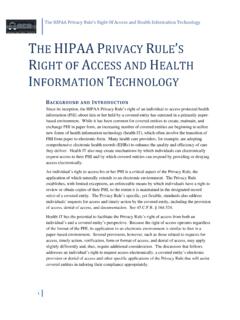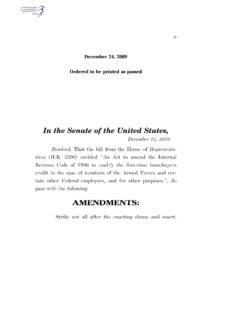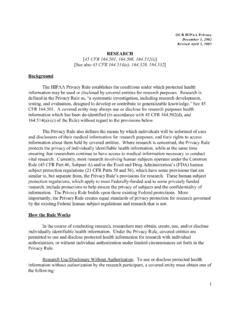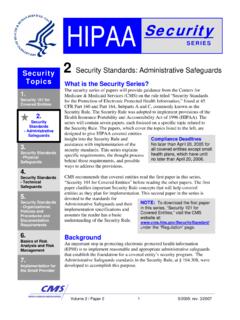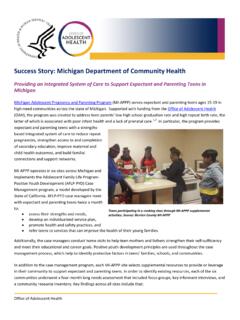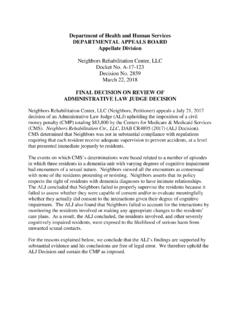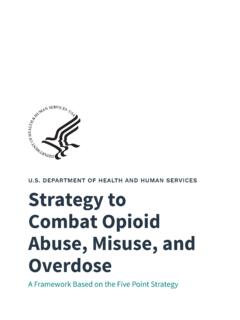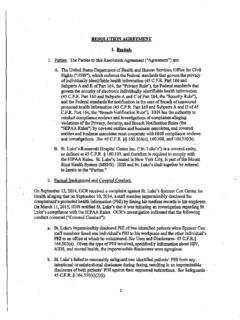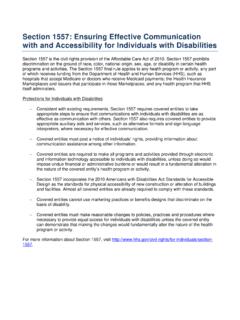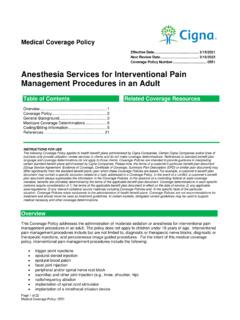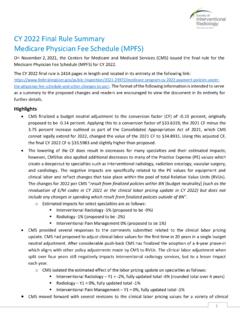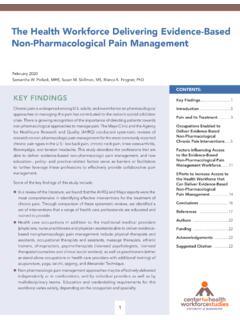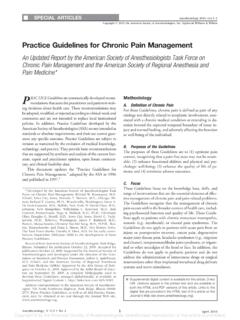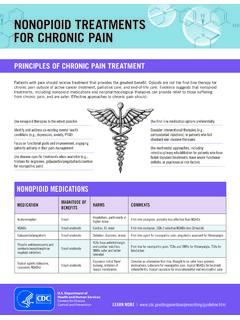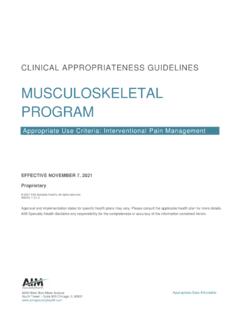Transcription of PAIN MANAGEMENT BEST PRACTICES - HHS.gov
1 EXECUTIVE SUMMARY1 EXECUTIVE SUMMARYPAIN MANAGEMENT best PRACTICES INTER-AGENCY TASK FORCE REPORTBEST PRACTICESPAIN MANAGEMENT best PRACTICES INTER-AGENCY TASK FORCE REPORTU pdates, Gaps, Inconsistencies, and RecommendationsPAIN MANAGEMENT FINAL REPORT2 Submitted by the: pain MANAGEMENT best PRACTICES Inter-Agency Task Force Report Date:May 9, 2019 Copyright Information:All material appearing in this report is in the public domain and may be reproduced or Department of Health and Human Services (2019, May). pain MANAGEMENT best PRACTICES Inter-Agency Task Force Report: Updates, Gaps, Inconsistencies, and Recommendations. Retrieved from U. S. Department of Health and Human Services website: OF CONTENTSiPAIN MANAGEMENT best PRACTICES INTER-AGENCY TASK FORCE REPORTE xecutive Summary ..1 Task Force Members ..5 Definitions ..91. Introduction ..112. Clinical best PRACTICES .. Approaches to pain MANAGEMENT .. Acute and Chronic pain .
2 Perioperative MANAGEMENT of Chronic pain Medications ..23 Acetaminophen ..24 NSAIDs ..24 Anticonvulsants ..24 Antidepressants ..24 Musculoskeletal Agents ..25 Antianxiety Medications ..25 Opioids .. Overdose Prevention Education and Naloxone .. Restorative Therapies ..31 Therapeutic Exercise ..31 Transcutaneous Electric Nerve Stimulation ..32 Massage ..32 Cold and Heat ..32 Therapeutic Ultrasound ..32 Bracing .. interventional Procedures ..33 Epidural Steroid Injections ..34 Facet Joint Nerve Block and Denervation Injection ..34 Cryoneuroablation ..34 Radiofrequency Ablation ..35 Peripheral Nerve Injections ..35 Sympathetic Nerve Blocks ..35 Neuromodulation ..35 Intrathecal Medication Pumps ..35 Vertebral Augmentation ..35 Trigger Points ..35 Joint Injections ..36 Interspinous Process Spacer Devices ..36 Regenerative/Adult Autologous Stem Cell Therapy ..36 TABLE OF CONTENTSiiPAIN MANAGEMENT best PRACTICES INTER-AGENCY TASK FORCE Behavioral Health Approaches.
3 37 Behavioral Therapy ..38 Cognitive Behavioral Therapy ..38 Acceptance and Commitment Therapy ..38 Mindfulness-Based Stress Reduction ..38 Emotional Awareness and Expression Therapy ..38 Self-regulatory or Psychophysiological Approaches .. Access to Psychological Interventions .. Patients with Chronic pain as well as Mental Health and Substance Use Comorbidities .. Complementary and Integrative Health ..41 Acupuncture ..43 Massage and Manipulative Therapies ..43 MBSR ..43 Yoga ..43 Tai chi .. Special Populations .. Unique Issues Related to Pediatric pain MANAGEMENT .. Older Adults .. Patients with Cancer-Related pain and Patients in Palliative Care .. Unique Issues Related to pain MANAGEMENT in Women .. Chronic Relapsing pain Conditions .. Sickle Cell Disease .. Health Disparities in Racial and Ethnic Populations, Including African-Americans, Hispanics/Latinos, American Indians, and Alaska Natives .. Military Active Duty, Reserve Service Members, and Veterans.
4 503. Cross-Cutting Clinical and Policy best PRACTICES .. Risk Assessment .. Prescription Drug Monitoring Programs .. Screening and Monitoring .. Stigma .. Education .. Public Education .. Patient Education .. Provider Education .. Policymaker, Regulator, and Legislator Education .. Access to pain Care .. Medication Shortage .. Insurance Coverage for Complex MANAGEMENT Situations .. Research ..66 TABLE OF CONTENTSiiiPAIN MANAGEMENT best PRACTICES INTER-AGENCY TASK FORCE REPORT4. Review of the CDC Guideline ..69 Federal Resources Center ..73 Acronyms ..79 References ..83 LIST OF FIGURESF igure 1: Percentage of Suicide Decedents with Chronic pain Aged 10 Years or Older, by Year, in 18 States ..12 Figure 2: The pain MANAGEMENT best PRACTICES Report was Framed by Congressional Legislation and Informed by Task Force Expertise ..14 Figure 3: Comparison of the 90-Day Comment Period to Public Comment Periods 1 and 2.
5 15 Figure 4: Acute and Chronic pain MANAGEMENT Consists of Five Treatment Approaches Informed by Four Critical Topics ..19 Figure 5: The Biopsychosocial Model of pain MANAGEMENT ..20 Figure 6: Individualized Patient Care Consists of Diagnostic Evaluation That Results in an Integrative Treatment Plan That Includes All Necessary Treatment Options ..21 Figure 7: Medication Is One of Five Treatment Approaches to pain MANAGEMENT ..23 Figure 8: Medication Approaches Include Opioid and Non-opioid Options ..24 Figure 9: Value of Poison Control Centers ..30 Figure 10: Restorative Therapies Are One of Five Treatment Approaches to pain 11: interventional Procedures Are One of Five Treatment Approaches to pain MANAGEMENT ..33 Figure 12: interventional Procedures Vary by Degree of Complexity and Invasiveness ..34 Figure 13: Behavioral Health Is One of Five Treatment Approaches to pain MANAGEMENT ..37 Figure 14: Overcoming Barriers to Behavioral Health Approaches.
6 39 Figure 15: Complementary and Integrative Health Is One of Five Treatment Approaches to pain MANAGEMENT ..41 Figure 16: Complementary and Integrative Health Approaches for the Treatment or MANAGEMENT of pain Conditions Consist of a Variety of Interventions ..43 Figure 17: A Risk Assessment Is Critical to Providing the best Possible Patient-Centered Outcome While Mitigating Unnecessary Opioid Exposure ..53 Figure 18: Public Comments to the Task Force Affirm the Barriers Stigma Creates ..57 Figure 19: Education Is Critical to the Delivery of Effective, Patient-Centered pain Care and Reducing the Risk Associated With Prescription Opioids ..59ivPAIN MANAGEMENT best PRACTICES INTER-AGENCY TASK FORCE REPORTEXECUTIVE SUMMARY1 EXECUTIVE SUMMARYPAIN MANAGEMENT best PRACTICES INTER-AGENCY TASK FORCE REPORTP atients with acute and chronic pain in the United States face a crisis because of significant challenges in obtaining adequate care, resulting in profound physical, emotional, and societal costs.
7 According to the Centers for Disease Control and Prevention, 50 million adults in the United States have chronic daily pain , with million adults experiencing high-impact chronic pain that interferes with daily life or work activities. The cost of pain to our nation is estimated at between $560 billion and $635 billion annually. At the same time, our nation is facing an opioid crisis that, over the past two decades, has resulted in an unprecedented wave of overdose deaths associated with prescription opioids, heroin, and synthetic pain MANAGEMENT best PRACTICES Inter-Agency Task Force (Task Force) was convened by the Department of Health and Human Services in conjunction with the Department of Defense and the Department of Veterans Affairs with the Office of National Drug Control Policy to address acute and chronic pain in light of the ongoing opioid crisis. The Task Force mandate is to identify gaps, inconsistencies, and updates and to make recommendations for best PRACTICES for managing acute and chronic pain .
8 The 29-member Task Force included federal agency representatives as well as nonfederal experts and representatives from a broad group of stakeholders. The Task Force considered relevant medical and scientific literature and information provided by government and nongovernment experts in pain MANAGEMENT , addiction, and mental health as well as representatives from various disciplines. The Task Force also reviewed and considered patient testimonials and public meeting comments, including approximately 6,000 comments from the public submitted during a 90-day public comment period and 3,000 comments from two public Task Force emphasizes the importance of individualized patient-centered care in the diagnosis and treatment of acute and chronic pain . This report is broad and deep and will have sections that are relevant to different groups of stakeholders regarding best PRACTICES . See the table of contents and the sections and subsections of this broad report to best identify that which is most useful for the various clinical disciplines, educators, researchers, administrators, legislators, and other key report emphasizes the development of an effective pain treatment plan after proper evaluation to establish a diagnosis, with measurable outcomes that focus on improvements, including quality of life (QOL), improved functionality, and activities of daily living (ADLs).
9 Achieving excellence in acute and chronic pain care depends on the following: An emphasis on an individualized, patient-centered approach for diagnosis and treatment of pain is essential to establishing a therapeutic alliance between patient and clinician. Acute pain can be caused by a variety of conditions, such as trauma, burn, musculoskeletal injury, and neural injury, as well as pain from surgery/procedures in the perioperative period. A multimodal approach that includes medications, nerve blocks, physical therapy, and other modalities should be considered for acute pain conditions. A multidisciplinary approach for chronic pain across various disciplines, using one or more treatment modalities, is encouraged when clinically indicated to improve outcomes. These include the following five broad treatment categories, which have been reviewed with an identification of gaps/inconsistencies and recommendations for best PRACTICES : Medications: Various classes of medications, including non-opioids and opioids, should be considered for use.
10 The choice of medication should be based on the pain diagnosis, the mechanisms of pain , and related co-morbidities following a thorough history, physical exam, other relevant diagnostic procedures and a risk-benefit assessment that demonstrates that the benefits of a medication outweigh the risks. The goal is to limit adverse outcomes while ensuring that patients have access to medication-based treatment that can enable a better QOL and function. Ensuring safe medication storage and appropriate disposal of excess medications is important to ensure best clinical outcomes and to protect the public MANAGEMENT best PRACTICES INTER-AGENCY TASK FORCE REPORTEXECUTIVE SUMMARY Restorative Therapies, including those implemented by physical therapists and occupational therapists ( , physiotherapy, therapeutic exercise, and other movement modalities) are valuable components of multidisciplinary, multimodal acute and chronic pain care.
